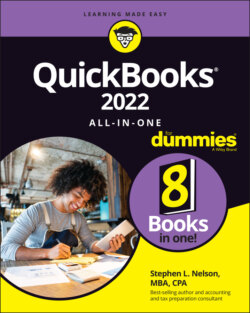Читать книгу QuickBooks 2022 All-in-One For Dummies - Nelson Stephen L., Stephen L. Nelson - Страница 79
The traditional close
ОглавлениеAs I hope you already know, revenue and expense accounts count revenue and expenses for a particular period of time. Revenue and expense accounts may count for the month, the quarter, or the year, for example.
One thing that accounting systems traditionally do is zero out the revenue and expense accounts at the end of the year. This makes sense if you think about it a bit. You want your counters reset at the beginning of the year so that counting the new year’s revenue and the new year’s expenses is easy. In the case of a trial balance like the one shown in Table 3-19, for example, you’d typically make the journal entry shown in Table 3-20.
TABLE 3-20 Journal Entry 19: Closing the Period
| Account | Debit | Credit |
|---|---|---|
| Sales revenue | $13,000 | |
| Cost of goods sold | $3,000 | |
| Rent | 1,000 | |
| Wages expense | 4,000 | |
| Supplies | 1,000 | |
| Owner’s equity | 4,000 |
If you look at Journal Entry 19 (Table 3-20), for example, you see that the first line in the journal entry is a $13,000 debit for sales revenue. If you look back at the trial balance shown in Table 3-19, you see that sales revenue has a $13,000 credit balance. The combination of the account balance shown in Table 3-19 and the closing entry shown in Journal Entry 19 (Table 3-20) effectively zeros out the sales revenue account.
The same sort of accounting magic occurs for each of the other expense accounts shown in the trial balance. The cost-of-goods-sold balance is equal to a $3,000 debit in Table 3-19 and is zeroed out in Journal Entry 19 with a $3,000 credit. And so it goes.
